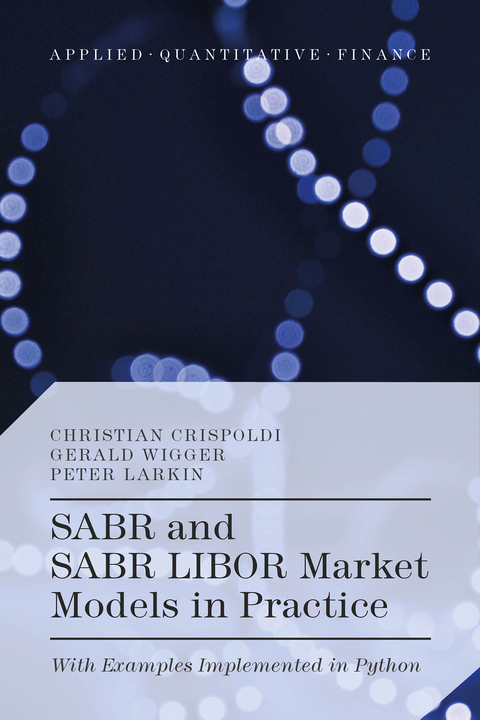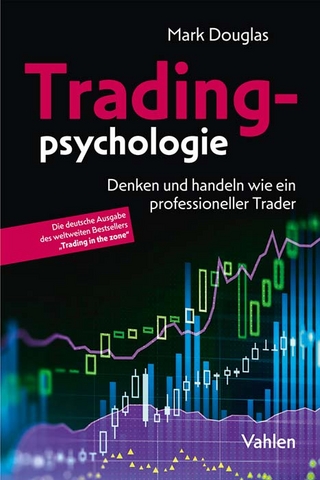SABR and SABR LIBOR Market Models in Practice
Palgrave Macmillan (Verlag)
978-1-137-37863-7 (ISBN)
SABR and SABR Libor Market Models in Practice is an accessible guide to modern interest rate modelling. Rather than covering an array of models which are seldom used in practice, it focuses on the SABR model, the market standard for vanilla products, the LIBOR Market Model, the most commonly used model for exotic products andthe extended SABR LIBOR Market Model. The book takes a hands-on approach, demonstrating simply how to implement and work with these models in a market setting. It bridges the gap between the understanding of the models from a conceptual and mathematical perspective and the actual implementation by supplementing the interest rate theory with modelling specific, practical code examples written in Python.
Christian Crispoldi is a Vice President at Nomura Holding America Inc., in New York where he is responsible for the valuation and pricing of interest rate derivatives. Previously he worked as a financial engineer in various banks across Europe. Christian holds a Masters degree in Mathematical Finance from the University of York, UK, and a bachelor degree in Computer Engineering from the University of Bologna, Italy. Gérald Wigger is Head of Quantitative Analysis at Weisshorn Re. He previously worked in various roles such as Head of Pricing at Axa Winterthur, Head of Risk Modeling at Zürcher Kantonalbank and Interest Rate Derivatives Quant at Bank of America Merril Lynch. Gérald holds a PhD in Solid State Physics from ETH Zurich. Peter Larkin is a Data Scientist working on building predictive models using big data in the (re) insurance industry. Previously he worked as a Quantitative Analyst in the financial services industry working on projects spanning the pricing of structured products, credit and market risk, and asset management. Peter has a background in Theoretical Physics and received his PhD from the University of York in 2008, previously having obtained his Masters at Cambridge University and BSc at Imperial College London. In 2012 he also completed a MSc in Mathematical Finance from the University of Oxford.
1. Introduction 1.1. Who Should Read This Book 1.2. Outline 1.3. Python, NumPy and SciPy 2. Interest Rate Derivatives Markets 2.1. Interest Rates 2.2. What You Need for Trading: ISDAs, Netting Agreement and CSAs 2.3. The Evolution of Complex Derivatives Trading 2.4. The Effects of the Financial Credit Crisis 3. Interest Rate Notions 3.1. Interest Rate Basics 3.2. The Multiple Curve Framework 3.3. Interest Rate Valuations and Measures 3.4. Volatility Trading 4. Vanilla Models 4.1. Lognormal Black Model 4.2. Normal Model 4.3. Risk Sensitivities 5. SABR Model 5.1. Introduction 5.2. SABR Parameters 5.3. PDE and Kolmogorov Equations 5.4. Hagan et al. Approximations 5.5. SABR Calibration in Practice 5.6. Risk Sensitivities 5.7. Monte Carlo Simulation Schemes for SABR 5.8. The Limits of Hagan et al. Approximations 5.9. Alternative SABR Approximations 5.10. Pricing in a Negative Forward Rate Regime: Shifted SABR Approximation 6. LIBOR Market Model 6.1. Introduction 6.2. Dynamics of the LIBOR Market Model 6.3. The Forward-Forward Correlation and Its Calibration Nelson Siegel Approach 6.4. Volatility Parametrization and Calibration 6.5. Simulation 6.6. Risk Sensitivities 7. SABR LIBOR Market Model 7.1. Introduction 7.2. Dynamics of the SABR LIBOR Market Model 7.3. The Correlation Matrix and Its Calibration 7.4. Rebonato et al. SABR LMM Parametrization 7.5. Simulation and Pricing A. Appendices A.1. Time Grid and Day Count Conventions A.2. A Note On Hyperbolic Geometry A.3. LIBOR Market Model in the HJM Framework A.4. Swap Market Model
| Erscheint lt. Verlag | 29.9.2015 |
|---|---|
| Reihe/Serie | Applied Quantitative Finance |
| Zusatzinfo | XXI, 216 p. |
| Verlagsort | Basingstoke |
| Sprache | englisch |
| Maße | 155 x 235 mm |
| Themenwelt | Mathematik / Informatik ► Mathematik ► Angewandte Mathematik |
| Naturwissenschaften | |
| Sozialwissenschaften | |
| Wirtschaft ► Allgemeines / Lexika | |
| Wirtschaft ► Betriebswirtschaft / Management ► Finanzierung | |
| Betriebswirtschaft / Management ► Spezielle Betriebswirtschaftslehre ► Bankbetriebslehre | |
| Wirtschaft ► Volkswirtschaftslehre ► Ökonometrie | |
| ISBN-10 | 1-137-37863-8 / 1137378638 |
| ISBN-13 | 978-1-137-37863-7 / 9781137378637 |
| Zustand | Neuware |
| Haben Sie eine Frage zum Produkt? |
aus dem Bereich




